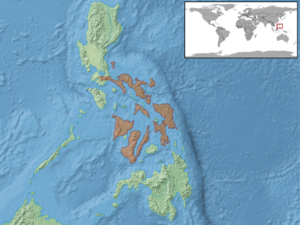Spiny waterside skink facts for kids
Quick facts for kids Tropidophorus grayi |
|
|---|---|
 |
|
| Conservation status | |
| Scientific classification | |
| Genus: |
Tropidophorus
|
| Species: |
grayi
|
 |
|
| Range of T. grayi in the Philippines | |
The spiny waterside skink is a cool lizard from the Philippines. It's also known as Gray's keeled skink, Gray's water skink, or the Philippine spiny stream skink. This skink is a type of lizard that lives only in the Philippines. It's a bit shy, but you can find quite a few of them there!
Contents
Where it Lives (Habitat)
The spiny waterside skink loves to live near water. You can find it in forests and by streams. It lives from sea level all the way up to about 800 meters (2,600 feet) high. Sometimes, it even lives in farm areas next to forests.
This skink gets its name "waterside skink" because it hangs out by rivers and lakes. Even though the Philippines is warm, this skink likes cooler spots. It often chooses mountainous areas where the air is a bit chillier.
What it Looks Like (Description)
The spiny waterside skink has really cool, spiky scales. They are usually grey-black, but some can be pure black. Others might be reddish-brown or wooden-brown. Its belly is white and super smooth and shiny. It might have some brown spots too.
Because of its spiky scales and long body, this skink looks a lot like a tiny crocodile!
How it Behaves (Behavior)
This skink is super fast and quick! Even though it looks a bit tough and can move quickly, it's actually harmless. If you try to pick it up, it might give you a hard bite, but it won't hurt you much.
When a predator tries to catch it, the spiny waterside skink has a clever trick. It hides in the water! If it's in deep water, it might even pretend to drown. It just stays perfectly still, playing dead. If you take it out of the water, it might stay motionless for a few minutes. Then, it will suddenly go back to normal. This skink is also a great climber. It has strong claws that help it grip tree trunks and other wooden things.
What it Eats (Diet)
The spiny waterside skink is a bit of a hunter. It likes to eat:
- Worms
- Insects
- Small snails
- Slugs
- Small fish (if it can catch them!)
As a Pet (In Captivity)
People are starting to keep spiny waterside skinks as pets. They are becoming popular because they look like tiny crocodiles. Plus, they are not too expensive to buy in the Philippines.
When they are kept as pets, these skinks often stack themselves up. They pile on top of each other, kind of like turtles sunbathing. Even though they are called "waterside skinks," they often prefer to stay on dry land when they are in a tank.
Tail Regeneration
Like many other skinks, the spiny waterside skink can regrow its tail. If its tail gets cut off, a new one will grow back! However, the new tail is usually shorter than the original. It also has fewer spikes. The tail of the spiny waterside skink is tougher to break off than the tails of most other skinks.
Reproduction (Life Cycle)
The spiny waterside skink gives birth to live young. This is a special way of having babies called ovoviviparous. It means the eggs hatch inside the mother's body, and then the babies are born alive.
- Size: Female skinks are about 20–25 cm (8–11 inches) long, including their tail. Males are a bit smaller, about 5–9 inches long.
- Babies: A mother skink usually has 1 to 6 live babies at a time.
- How Common: This skink is "locally common." This means you can find a lot of them in certain areas.
Why it's Called Grayi
The second part of the skink's scientific name, grayi, is a special tribute. It honors a British scientist named John Edward Gray. He studied reptiles and other animals.


